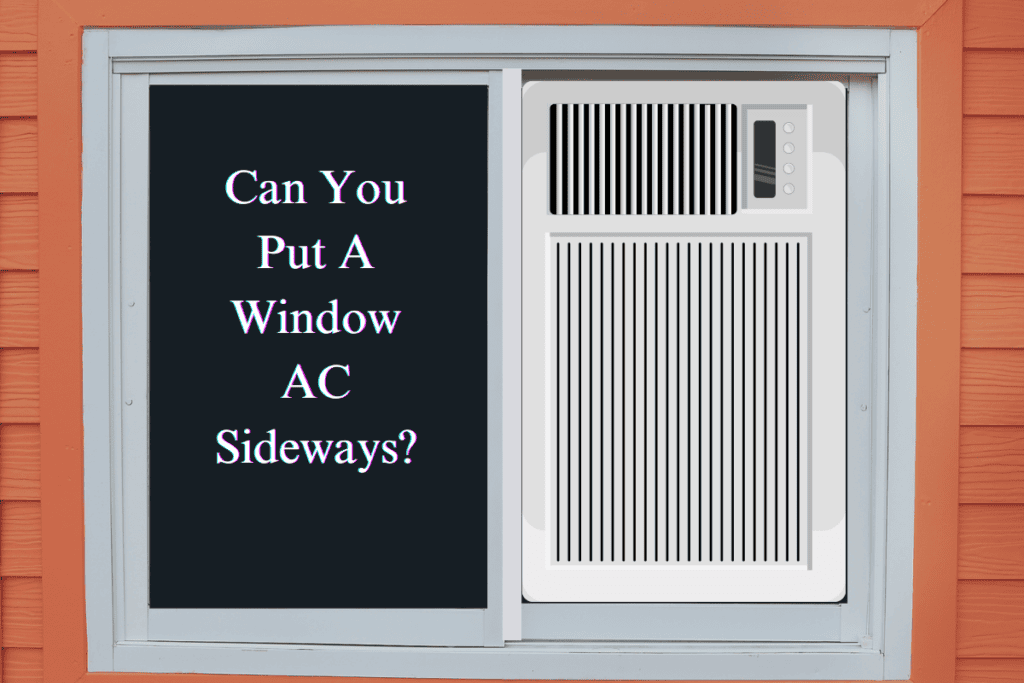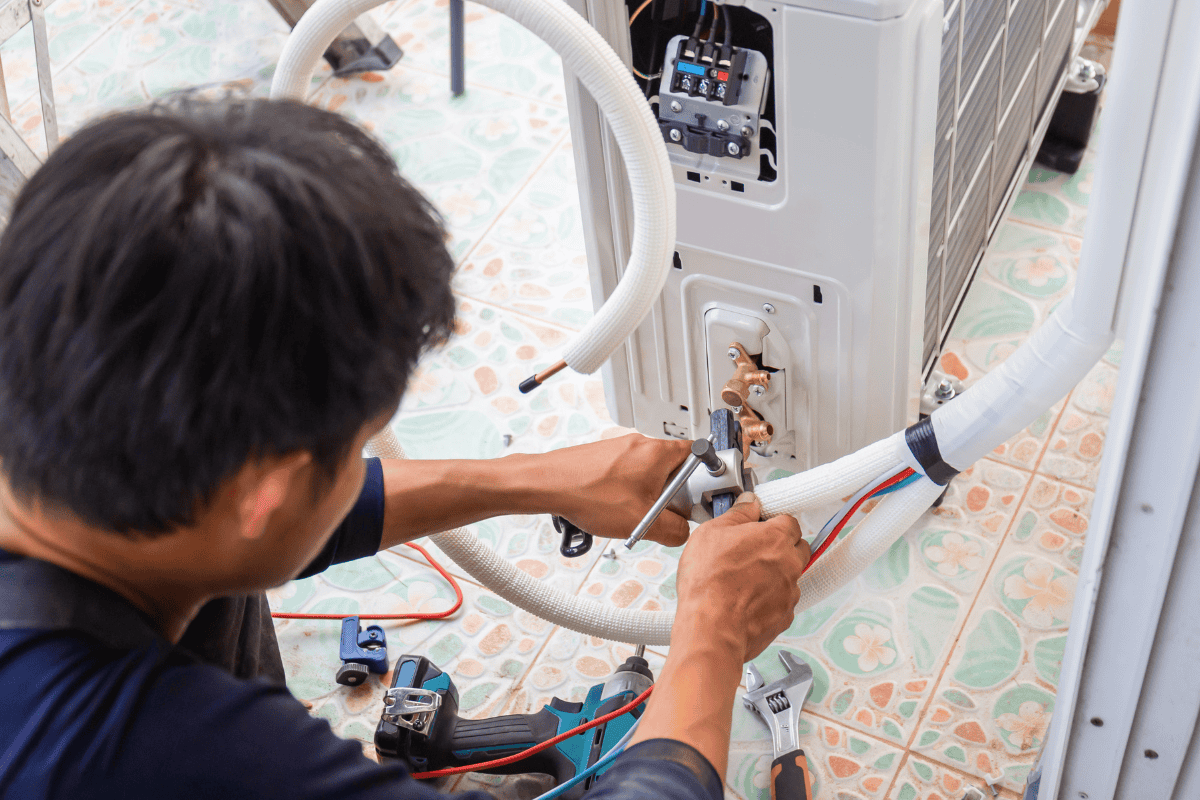Can You Put Window Air Conditioner Sideways? Risks & Alternatives
- Fact Checked

- Fact Checked
When installing a new window air conditioner, homeowners often face the challenge of fitting the unit into a window opening that is too narrow, particularly in the case of horizontally sliding windows. This space constraint may lead some to consider installing the air conditioner on its side as a potential solution.
However, before attempting a sideways installation, it is crucial to understand the risks and drawbacks associated with this approach. Installing a window air conditioner on its side can have significant consequences for the unit’s performance, efficiency, and longevity.
In this article, we will explore the reasons why installing a window air conditioner on its side is not recommended and discuss the potential problems that can arise from doing so. We will also provide alternative solutions for those dealing with narrow window openings, so that you can safely and effectively cool your living space without compromising the functionality of your AC unit.
Contents
Should You Install a Window AC Sideways?
HVAC specialists strongly advise against placing air conditioners on their side, even during transport or storage. Most AC units are designed to operate in an upright position, for optimal performance and preventing overheating or internal stress. Even a slight tilt or incline can significantly reduce the system’s efficiency and cause severe damage to its components, including the compressor and coils.
Moreover, window air conditioners typically feature built-in dehumidifiers that rely on gravity for proper function. When an AC unit is positioned on its side, it cannot effectively drain excess condensation, leading to reduced efficiency and potential water damage.
Sideways installation of a window unit may also disrupt the unit’s internal mechanisms due to inadequate lubrication, resulting in suboptimal cooling performance and airflow.
Risks Associated with Sideways Installation
1. Structural Integrity
Installing a window AC sideways can compromise the structural integrity of both the unit and the surrounding window frame. The improper distribution of weight and undue pressure exerted on the structure may lead to damage over time, jeopardizing the stability and safety of the installation.
2. Airflow Disruption
Air conditioners are engineered to direct airflow in a specific pattern for optimal cooling and circulation. When turned sideways, the intended airflow direction is disrupted, reducing the unit’s efficiency and potentially straining internal components like the compressor and fan. This can result in premature wear and tear or even malfunction.
3. Drainage Issues

Proper drainage is essential for the functioning of window air conditioners. Sideways placement poses challenges in effectively removing condensate from the unit, increasing the risk of water accumulation. This not only impacts the AC’s performance but can also lead to water damage, structural issues, and the growth of mold or mildew.
4. Energy Efficiency and Cooling Performance
Installing an air conditioner sideways can significantly decrease its energy efficiency and cooling performance. The disruption of optimal functioning may result in higher electricity consumption and insufficient temperature regulation, leaving occupants uncomfortable and driving up energy costs.
Considerations for Narrow Window AC Units
For homeowners faced with narrow window openings, specialized AC units designed specifically for these scenarios offer a viable solution. Manufacturers have developed window air conditioners with slim profiles and compact designs that can fit seamlessly into tight spaces without compromising cooling efficiency.
When exploring narrow window AC options, consider the following factors:
1. Cooling Capacity
Evaluate the cooling capacity of different units so that they meet the size and cooling requirements of the intended space. Measure your window dimensions and consult with professionals to determine the appropriate BTU rating for optimal performance.
2. Energy Efficiency
Compare the energy efficiency ratings (EER) of various narrow window AC units. Opting for a more energy-efficient model can help minimize electricity consumption and operating costs while still providing effective cooling.
3. Installation Flexibility
Assess the installation requirements and compatibility of the AC unit with your specific window configuration, such as single-hung, double-hung, or casement windows. Some units may offer more versatile installation options, making them suitable for a wider range of window types.
Recommendations for Optimal Cooling Solutions
For best cooling performance and to avoid the risks associated with sideways installation, consider the following recommendations:
1. Proper Sizing
Select a narrow window AC unit that is appropriately sized for the room’s dimensions and cooling load. Consult with professionals or use online sizing calculators to determine the optimal BTU rating for your space.
2. Sealing and Insulation
Prioritize proper sealing and insulation around the AC unit and window opening to prevent air leakage and maximize cooling efficiency. Use weatherstripping, foam sealant, or other appropriate materials to create a tight seal and minimize energy loss.
3. Supplemental Cooling
For rooms with extremely narrow or unconventional window configurations, consider alternative cooling solutions such as portable AC units or ductless mini-split systems. These options offer more flexibility in terms of placement and can provide effective cooling without the need for window installation.
Contact HVAC Angel For HVAC Installation
At HVAC Angel, we understand the importance of proper air conditioner installation for optimal cooling performance and energy efficiency. That’s why we have partnered with several licensed HVAC companies so that our customers receive the highest quality service.
When you choose HVAC Angel for your air conditioner installation, you can trust that you’re in good hands. Our technicians are highly skilled and knowledgeable, adhering to industry best practices and safety standards. Whether you have a narrow window that requires a specialized AC unit or need guidance on selecting the right system for your home, our experts are here to assist you every step of the way.
Don’t let the challenges of window air conditioner installation hold you back from enjoying a cool and comfortable home. Trust HVAC Angel to deliver exceptional service and expertise. Contact us today to schedule your HVAC installation and experience the difference of working with a reliable and customer-focused company.
Frequently Asked Questions
1. Can I use a window AC unit without a window?
While window air conditioners are primarily designed for installation in windows, it is possible to use them without a window by creating a custom opening in a wall or using a specialized mounting kit. However, this requires professional modification and may not be feasible in all cases.
2. Can I tilt window AC?
It is not recommended to tilt a window air conditioner, as it can disrupt the unit’s internal mechanisms and cause damage. Window AC units are designed to operate in an upright position, and tilting them can lead to improper refrigerant flow, reduced efficiency, and potential compressor failure.
3. How much tilt for window air conditioner?
Ideally, a window air conditioner should be installed with a slight tilt of about 1/4 inch towards the exterior to facilitate proper condensate drainage. However, this tilt should be limited to the specified range and should not exceed a few degrees to avoid compromising the unit’s performance and longevity.



